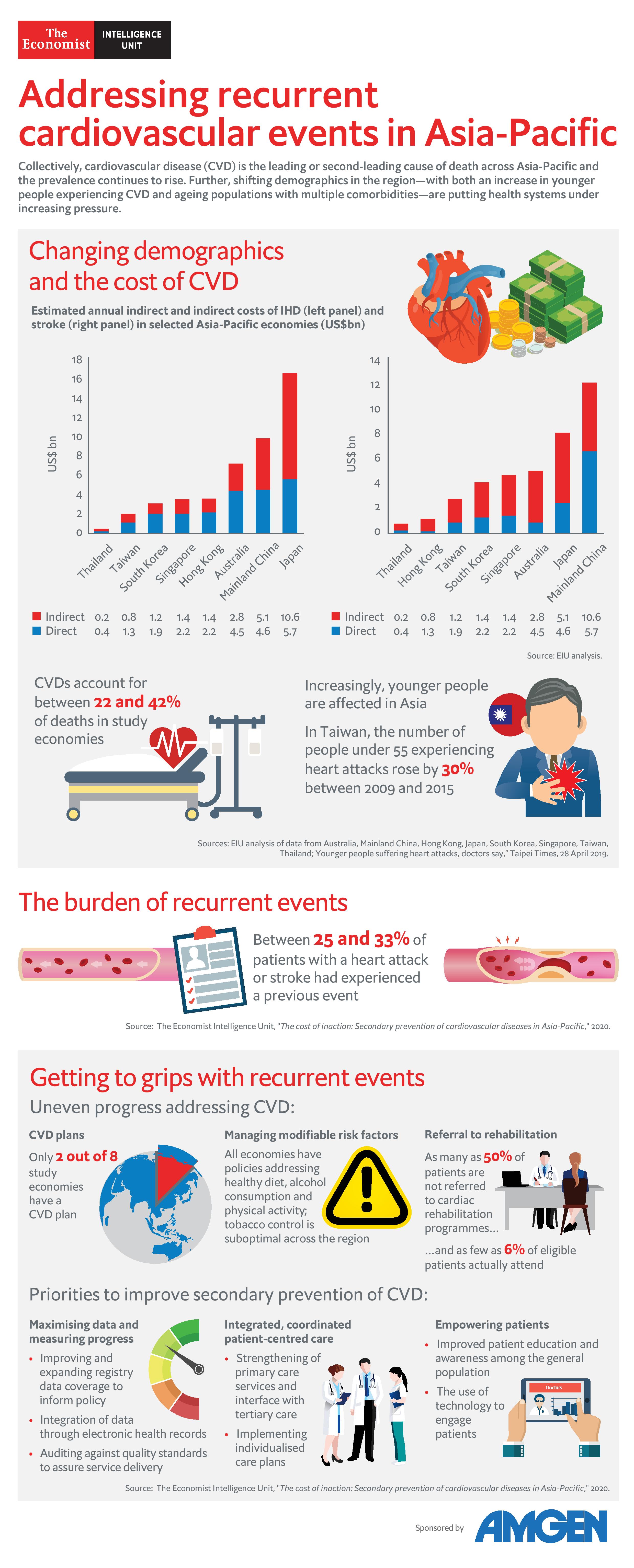
Addressing recurrent cardiovascular events in Asia-Pacific
Download InfographicHealth
Addressing recurrent cardiovascular events in Asia-Pacific

Jesse is a managing editor for Economist Impact based in Asia, with a focus on healthcare.
Based in Hong Kong, Jesse has been working in Asia for over 10 years. Prior to the Economist Impact, he held roles in medical education, scientific publications and medical communications, working in multinational biopharmaceutical companies with a focus in vaccines and biologic medicines. Jesse has extensive experience researching and collating medical information and working with healthcare professionals and patient organisations to develop insight-driven communications programmes.
Jesse holds a BSc in Anatomy and Physiology from the University of Leeds. His editorial interests include the policy response to emerging public health issues and patient advocacy in infectious diseases.
The cost of inaction
Related content

조치 부재의 비용: 아시아 태평양 지역 내 심혈관 질환의 2차 예방
아시아 태평양 지역의 심혈관 질환(CVD)부담은 국가별로 상이하나 모두 상당하다.CVD는 지역 전반에서 사망 원인 1위 또는2위를 차지하고 있으며, 유병률도 계속높아지고 있다. 또한 CVD를 경험하는 젊은환자와 여러 동반 이환을 가진 고령화 인구두 집단 모두의 증가라는 지역 내 인구통계적변화로 인해 각국의 보건의료체계에 부하가걸리고 있다.
CVD 관련 문제 해결에 관한 진척은 1차예방 분야에 초점이 맞춰져 이루어져왔으며, CVD의 연령표준화 발생률은감소하기 시작했다. 그러나 여전히 허용할수 없는 높은 수준의 심장마비 및 뇌졸중재발률과 그에 따른 경제적 및 인적 비용이존재해 이러한 진척을 저해하고 있다. 첫심장마비 또는 뇌졸중 생존자가 더많아짐에 따라 2차 사건 관련 부담이증가할 가능성이 높다. 이는 긴급한 주의를요구하는 상황인 동시에, 해당 환자 집단의관리와 결과를 개선할 수 있는 탁월하고현실적인 기회이기도 하다.
본 이코노미스트 인텔리전스 유닛분석에서는 아시아 태평양 지역8개국(호주, 중국, 홍콩, 일본, 싱가포르,한국, 대만, 태국)의 2차 심혈관 사건관리에 대한 정책적 대응을 살펴본다. 본 연구의 주요 결과는 다음을 포함한다. 관련 정책은 확실히 존재하나, 정책이상당히 포괄적인 국가도 있고 그렇지 않은국가도 있다. 조절 가능한 위험인자에 대한 정책을 법률과실천에 성공적으로 반영했는지 여부와 그로인한 영향은 아직 확인되지 않았다. 정부 감사가 결여되어 있다. 통합 관리의 핵심 요소인 1차 의료 체계가발전하고 있다. 재활 서비스가 존재하나 보장 범위가제한적이며, 업체들은 환자 유치와 유지에어려움을 겪고 있다. 필요한 목표는 환자 중심의 통합적이고조정된 관리 환자 권한부여는 성공의 핵심 데이터 극대화 및 진척도 측정
高まる二次予防の重要性: アジアにおける心疾患医療の現状・課題
国によって状況は異なるものの、心血管疾患(CVD)がもたらす負担が非常に大きいことは間違いない。CVD は全てのアジア諸国で二大死因となっており、患者数も増加の一途を辿っている。またアジアでは、若年層のCVD 患者・高齢者層の合併症患者が並行して増えており、医療体制にさらなる負担をもたらしている。
近年、CVD に関連する問題への対策は、一次予防の分野で進化を遂げつつあり、年齢調整罹患率にも減少の兆しが見られる。しかし急性心筋梗塞・脳卒中の再発率は依然として高く、その経済的・人的コストも大きいのが実状である。また一度目の発症での生存率が向上している今、再発によって生じる負担はさらに増す可能性が高い。ただし、対応が急務となっているこうした現状に取り組むことが現実的であることを鑑みると、当該患者グループのケア体制・アウトカムを向上させる重要な機会だと捉えることができる。
ザ・エコノミスト・インテリジェンス・ユニット(EIU)の本報告書は、アジア太平洋地域8 カ国(オーストラリア・中国・香港・日本・シンガポール・韓国・台湾・タイ)を対象として、CVD の再発予防に向けた政策的取り組みを検証する。
主要な論点は以下の通り:
多くの国はCVD 政策を掲げているが、包括性の面で大きな差がある。 改善可能なリスク因子への取り組みは、具体的な法案・行動計画、および成果評価に必ずしも結びついていない。 政府による成果評価の仕組みは発展途上である。 包括医療に不可欠なプライマリケアは近年進化を遂げつつある。 多くの国はリハビリサービスを実施しているが、提供能力は限られており、利用者も伸び悩んでいる。 連携を通じた患者中心の包括医療の必要性 取り組みの成功の鍵を握るのは患者エンパワーメント データ活用の加速と成果評価の仕組みも重要な鍵となる
Data and digital technologies to improve clinical outcomes for high-risk ca...
Cardiovascular diseases (CVD) account for around one quarter of deaths in Australia.1 The Economist Intelligence Unit estimates that the annual direct and indirect costs of CVD in Australia totals US$12.3bn.2 There are numerous modifiable risk factors for CVD, but the most important include hypertension (high blood pressure), high cholesterol, tobacco use, diabetes and obesity.3 While much of the recent focus has been on primary prevention through lifestyle modification, those highrisk patients with existing CVD—such as peripheral artery disease or a previous heart attack or stroke—require particular attention to avoid further morbidity and mortality.
The improved use of data and digital health tools has the potential to enable more coordinated and patient-centred models of care. The Digital Health CRC takes this further in saying “research and innovation in digital health offers Australia significant economic and business development opportunities, as well as great promise for the better health of our community”.4
On 27 May 2020, The Economist Intelligence Unit—supported by the Australian Cardiovascular Alliance (ACvA) and Digital Health CRC and with sponsorship from Amgen—convened a virtual roundtable discussion with 25 representatives from across the Australian cardiovascular healthcare landscape.
Co-hosted by the Economist Intelligence Unit with Dr Gemma Figtree, president of ACvA and professor in medicine at University of Sydney & Royal North Shore Hospital, and Dr Tim Shaw, director of research and workforce capacity at Digital Health CRC, the roundtable aimed to identify barriers, challenges and opportunities to improve outcomes for highrisk CVD patients by improving the use of data and digital technologies.
1 Australian Institute of Health and Welfare. Cardiovascular disease. In: Welfare AIoHa, editor. Canberra 2019. 2 Economist Intelligence Unit. “The cost of silence: Cardiovascular disease in Asia”, 2019 3 Centers for Disease Control and Prevention. “Know your risk for heart diseases”. Available from: https://www.cdc.gov/heartdisease/risk_factors.htm (Accessed Jun 2020). 4 Digital Health CRC. “About us”. Available from: https://www.digitalhealthcrc.com/about-us/ (Accesed Jun 2020).


